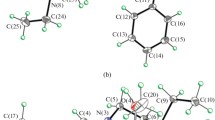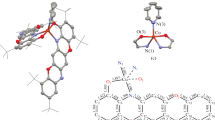Abstract
The reaction of aquo-ethanolic solutions of Co(II), Ni(II) and Cu(II) salts and ethanolic solution of capric acid hydrazide (L) yielded paramagnetic, high-spin bis- and tris(ligand) chelate complexes. The tris(ligand) complexes, [ML 3]X 2·nH2O [M=Co(II), Ni(II);X=NO −3 , ClO −4 , 1/2SO 2−4 ], have an octahedral structure formed on account of the bidentate (NO) coordination of three neutral hydrazide molecules. In the bis(ligand) complexes,ML 2(NCS)2 [M=Co(II), Ni(II)] and CuL 2 X 2·nH2O (X=NO −3 , ClO −4 and 1/2SO 2−4 ), the oxoanions and NCS− take also part in coordination. The complexes have been characterized by elemental analysis, IR spectra, magnetic measurements, molar conductivity and TG analysis.
Zusammenfassung
Durch die Reaktion von wäßrig-ethanolischen Lösungen von Co(II)-, Ni(II)-und Cu(II)-Salzen mit einer ethanolischen Lösung von Caprinsäurehydrazid (L) wurden paramagnetische high-spin Bis- und Tris-Ligand-Chelatkomplexe erhalten. Tris-Ligand-Komplexe des Typs [ML 3 X 2·nH2O [M=Co(II), Ni(II);X=NO −3 , ClO −4 , 1/2SO 2−4 ], die eine oktaedrische Struktur besitzen, entstehen durch die Koordination von drei neutralen zweizähnigen (NO)-Hydrazidmolekülen. Bei den Bis-Ligand-KomplexenML 2(NCS)2 [M=Co(II), Ni(II)], sowie bei den Bis-Ligand-Komplexen CuL 2 X 2·nH2O (X=NO −3 , ClO −4 , 1/2SO 2−4 ) nehmen bei der Koordination außer Hydrazid auch die Säurereste teil. Die Komplexe wurden durch Elementaranalyse, IR-Spektren, magnetische Messungen, molare Leitfähigkeit und TG-Analysen charakterisiert.
Similar content being viewed by others
References
Kharitonov YuYa, Machkhosvili RI (1971) Zh Neorg Khimii 16: 924
Kharitonov YuYa, Machkhosvili RI, Metreveli DP (1976) Koordinatsionnaya khimiya 2: 131
Mostafa MM, Nicholls D (1981) Inorg Chim Acta 51: 35
Machakhoshvili RI, Shalamberidze TV, Shchelokov RN (1982) Zh Neorg Khim 27: 1226
Machkhoshvili RI, Shalamberidze TV, Shchelokov RN (1982) Zh Neorg Khim 27: 1725
Grekov AP, Veselov VYa (1979) Fizicheskaya khimiya gidrazina, Kiev: Naukova dumka
Cotton FA, Wilkinson G (1971) Advanced inorganic chemistry. Wiley-Interscience, New York
Nakamoto K (1970) Infrared spectra of inorganic and coordination compounds. Wiley Interscience, New York
Geary WJ (1964) Coord Chem Rev 51: 285
Grekov AP (1966) Organicheskaya khimiya gidrazina. Tekhnika: Kiev
Schwarzenbach G, Flaschka H (1965) Die komplexometrische Titration. Ferdinand Enke, Stuttgart
Author information
Authors and Affiliations
Rights and permissions
About this article
Cite this article
Chundak, S.J., Leovac, V.M. & Bjelica, L.J. Coordination compounds of Co(II), Ni(II) and Cu(II) with capric acid hydrazide. Monatsh Chem 118, 923–930 (1987). https://doi.org/10.1007/BF00815319
Received:
Revised:
Accepted:
Issue Date:
DOI: https://doi.org/10.1007/BF00815319




